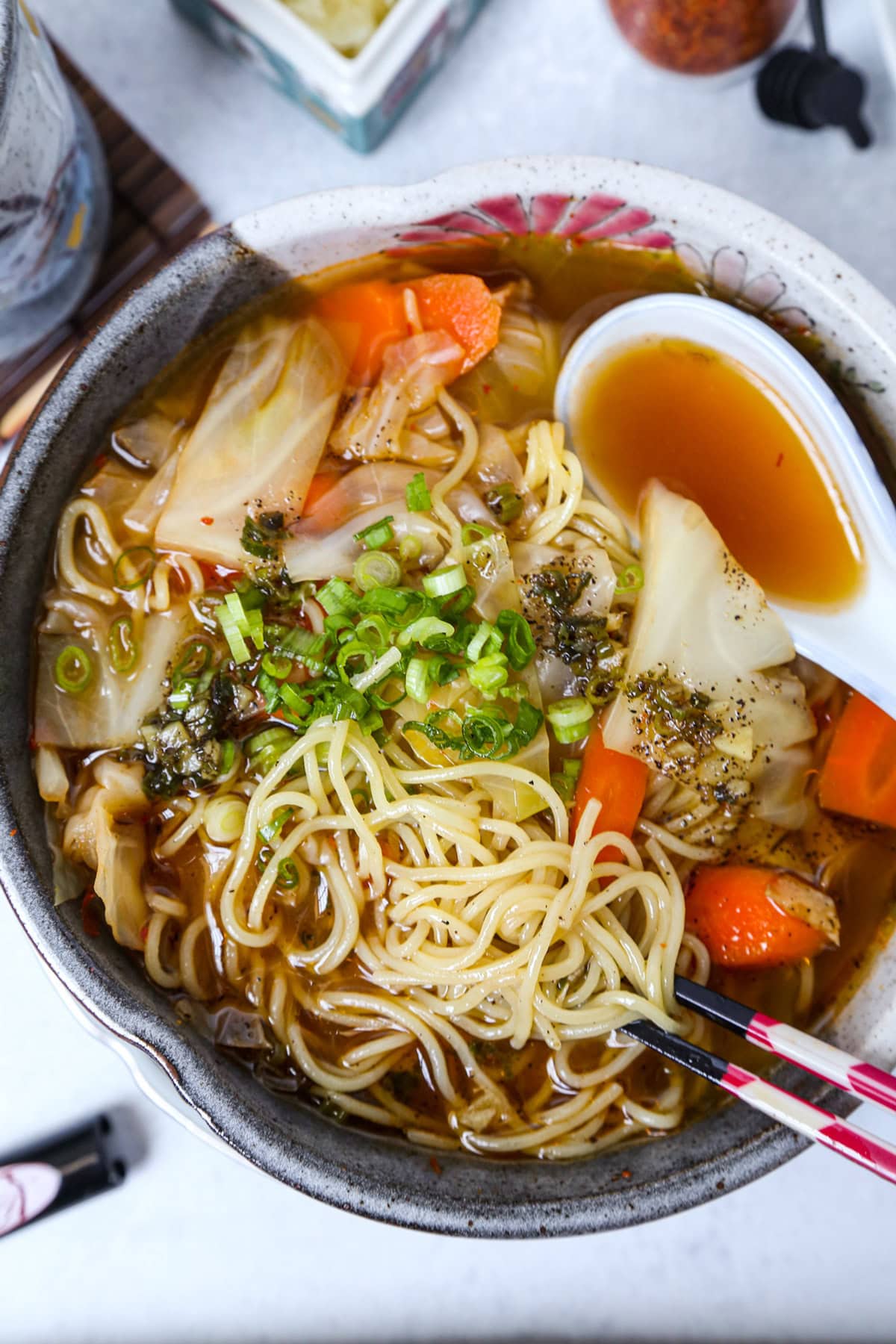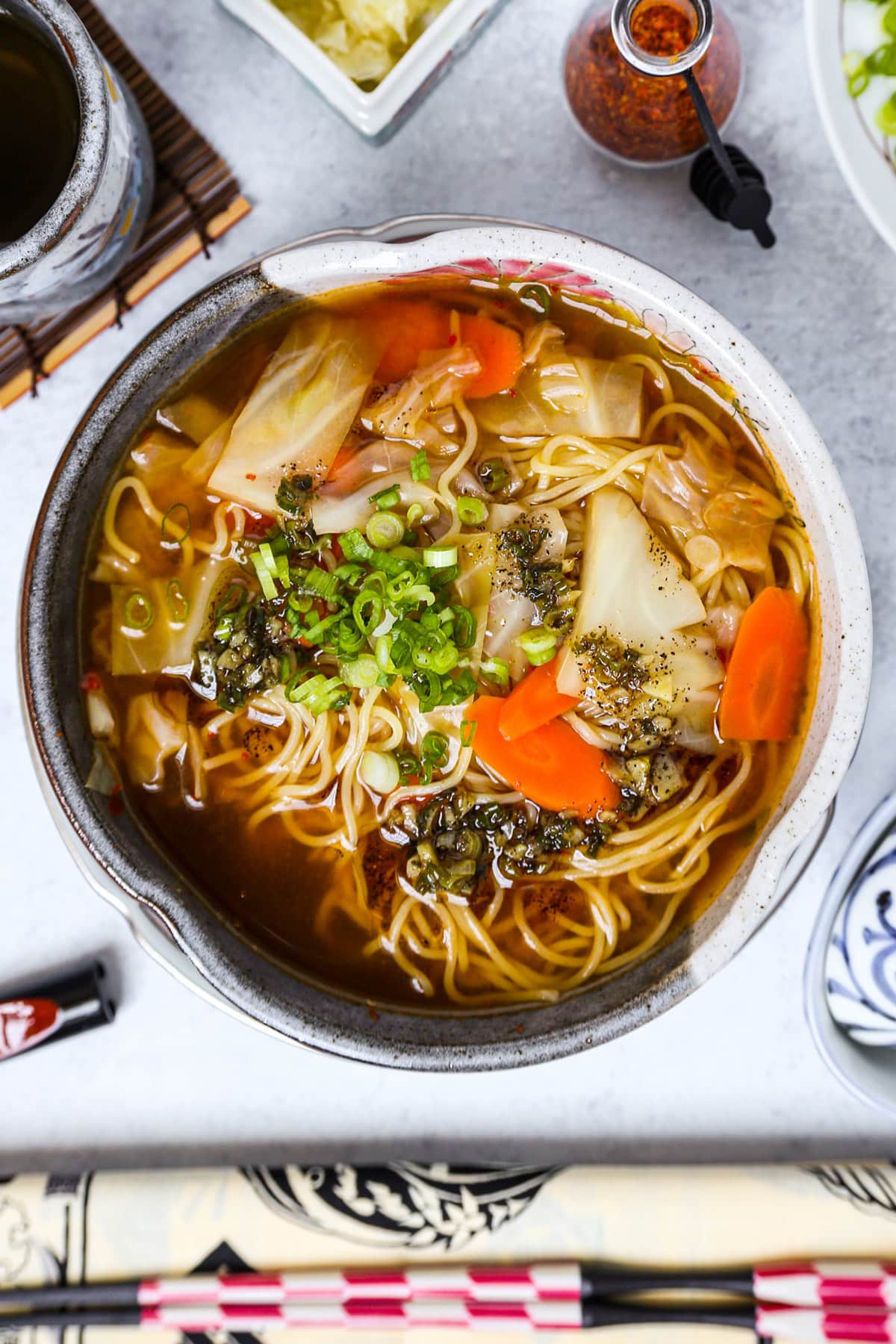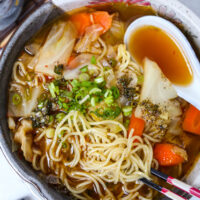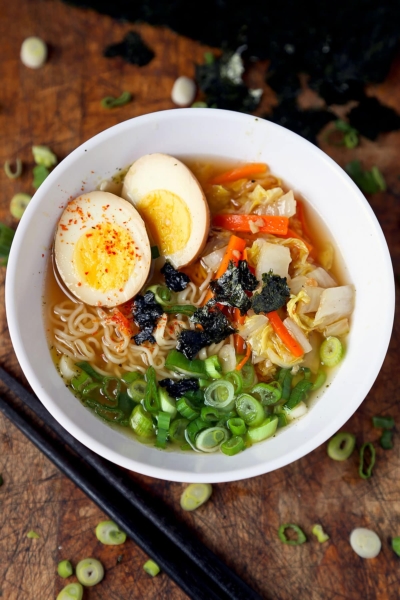This spicy miso ramen has an umami, fiery kick to it. Learn how to easily make restaurant quality ramen at home by whipping up a flavored ramen oil to drizzle on top. Homemade ramen ready in 25 minutes from start to finish!

Every region in Japan has its own proprietary ramen. My mother is from Fukuoka, in the south of Japan. Therefore, when I was a kid, every time we went for a visit over our summer holiday, we’d indulge in the regional specialty: tonkotsu ramen.
On those trips, we actually ate ramen like we were making up for lost time! I’ll always love that lusciously thick bone broth
But when it comes to cooking at home, I prefer to keep it on the lighter side of things – without sacrificing flavor.
Enter spicy miso ramen.
Where is Miso Ramen From?
Miso ramen hails from Hokkaido – which is the northernmost main island in Japan. And the main flavor element in miso ramen broth actually comes from miso paste.
What is Miso Paste?
It’s a fermented soybean paste with a ton of earthy, umami tasting notes (and just the slightest hint of sweetness around the edges). Read all about miso paste in Japanese cooking here.
Miso paste is the secret weapon in the miso tare I use in my homemade miso ramen recipe.
And for this spicy miso ramen recipe, we’ll be using miso paste – alongside heavy hitters like tobanjan and gochugaru to bring the savory heat. We’ll also be making a flavored oil to round out the ramen soup.
Do you like it spicy? You’re going to love this easy homemade Japanese ramen recipe!

Spicy Miso Ramen Ingredients
Scroll all the way down to the recipe card for the full recipe.
- Stock: Use powdered vegetable or chicken stock. This lays down a mildly savory base of flavor for the ramen soup.
- Soy Sauce: You’ll only need 1 tbsp soy sauce for this spicy miso ramen.
- Tobanjan: Tobanjan is a spicy chili bean paste. Much like miso, it is made with fermented soybeans. But tobanjan also contains chilis which make it spicy. It imparts funky, umami fire to the broth.
- Gochugaru: This is powdered Korean chili flakes. It ranges from fairly mild to volcanic. But the main thread from brand to brand is a deep smoky flavor. It’s fairly easy to track down at most Asian grocery stores these days. Or you can grab gochugaru here on Amazon.
- Ramen Noodles: I prefer fresh ramen – but use what you like and what you’ve got handy. I like to pull my noodles from the boiling water a little early, while they’re just short of al dente, since they’ll be going straight into the hot soup. More on the noodles in a sec.
- Cabbage and Carrot: You’ll simmer these veggies in the soup until they are beginning to soften, yet still retain a pliant crunch. About 5 mins is all it takes.
- Miso Paste: You can use white miso paste, which is the mildest in terms of flavor. Or use awase miso paste (a more assertive mixture of white and red miso).
- Green Onion: Fresh chopped scallions always add the best verdant flavor and crunch to a bowl of ramen. And you’ll want a bit extra to use in the flavored oil.
- Ramen Flavored Oil: A simple yet effective mixture of sesame oil, minced garlic, chopped green onion, ground black pepper, and salt. This instantly levels up the flavor to restaurant quality.

Best Noodles For Ramen
Traditional ramen noodles are wheat noodles – prepared with salt and alkaline water. And there are a ton of different variations to choose from when it comes to appearance.
Some ramen is thick, some thin. There are long, straight noodles – and some are wavy. What you use will largely boil down to personal preference.
- I prefer fresh ramen noodles (it’s fairly easy to track fresh ramen down at most Asian grocery stores these days).
- However, you can also use dried ramen to great effect. And, in a pinch, you can even use the block of noodles from a packet of Top Ramen (minus the seasoning packet of course).
Feel free to use what you prefer – and what you’ve got handy.
While traditional ramen noodles do not contain egg as an ingredient, if you’re making vegan ramen, just make sure to have a look at the ingredients list on the noodle package. Some fresh and dried Chinese egg noodles have a similar appearance to Japanese ramen.

How To Make Spicy Miso Ramen (Instructions)
- Gather all of your kitchen tools and ingredients.
- Make the flavored oil by placing sesame oil, chopped scallions, minced garlic, ground black pepper and salt in a small pot over low heat. Stir consistently until the garlic and scallion start to change color (about 4 minutes). Careful, this can burn quickly!
- Once the garlic and scallions are golden, turn the heat off and pour the flavored ramen oil into a small bowl and set aside.
- Next, prepare the ramen broth. Start by placing the water into a medium pot and bring to a boil.
- Then add the powdered stock, tobanjan, soysauce and dochugaru – and stir well. Turn the heat to low (bubbling simmer) and add the cabbage and carrots. Cover the pot with a lid and simmer for 5 minutes.
- Cook your noodles. Bring a large pot of water to boil and follow the instructions on your ramen noodle package of choice. If you’re using fresh ramen, they don’t take long! About 1 to 2 minutes. Drain the cooked noodles and leave them in the strainer.
- Finally, assemble the ramen. Divide the miso paste equally in two serving bowls and add the ramen broth and vegetables. Stir until the miso paste dissolves. Add the ramen noodles to the soup and drizzle the flavored oil on top. Top with chopped scallions and serve immediately.

The Best Ramen Toppings
Aside from the simmered cabbage and carrots I’m using in this vegetarian spicy ramen, I (almost) always top a bowl of ramen with chopped scallions. However, you can go wild with your ramen toppings. Some iconic examples include:
- Chashu (braised pork belly)
- Menma (lacto-fermented bamboo shoots)
- Ajitsuke Tamago (Ramen Eggs)
- Togarashi (a Japanese spice blend that features crushed chili flakes)
- Nori (dried seaweed sheets)
- Minced garlic cloves
- Rayu (Japanese chili oil)
What Does Spicy Miso Ramen Taste Like?
There’s a smoky earthiness at the forefront from the miso paste. That smokiness in particular is amplified from the umami loaded tobanjan and fiery gochugaru.
The small amount of soy sauce acts in tandem with the miso paste to elevate those savory undertones so the spicy miso broth isn’t too spicy.
However, I’d say that it’s the flavored ramen oil that brings the entire dish together. It imparts peppery, garlicky and nutty notes – resulting in one of the most full flavored homemade ramen recipes I’ve ever made in my home kitchen.

Can You Store Leftovers?
This spicy miso ramen is really only good fresh and hot. I would not recommend storing leftovers of the composed dish in the refrigerator at all. The ramen noodles in particular become a soggy mess if stored for any length of time in the soup.
- That said, you can store any leftover ramen broth in the fridge for 2-3 days – as long as you store it separately from the fresh noodles and ramen toppings.
- Leftovers of the flavored oil should be stored in a jar and kept in a cool, dark place for up to 3 weeks.
Other Delicious and Easy Ramen Recipes

TABLEWARE
Like some of the tableware in this post? They are available at Musubi Kiln.
Musubi Kiln is an online store specializing in high quality handmade Japanese tableware and dinnerware. Each product is made by Japanese craftsmen using traditional techniques that have been passed down from generation to generation.
Receive 10% off your purchase when using the code CAROLINE at checkout.
Did you try this spicy miso ramen recipe? Are there changes you made that you would like to share? Share your tips and recommendations in the comments section below!
Print
Spicy Miso Ramen
- Prep Time: 10 minutes
- Cook Time: 15 minutes
- Total Time: 25 minutes
- Yield: 2 1x
- Category: Noodles
- Method: Stove top
- Cuisine: Japanese
- Diet: Vegetarian
Description
You’ll love the fiery kick in this spicy miso ramen! Topped with the best flavored ramen oil – and so easy to make at home from scratch.
Ingredients
- 800ml water
- 1 teaspoon powdered chicken stock or vegetable stock
- 1 tablespoon soy sauce
- 1 teaspoon tobanjan
- 1 teaspoon gochugaru
- 2 packets fresh ramen noodles (3 to 4 ounces per packet)
- 5 oz cabbage chopped into bite size pieces
- 1/2 small carrot, finely sliced
- 1 1/2 tablespoon white miso paste or awase miso paste
- 2 scallions, chopped
Flavored oil
- 3 tablespoons sesame oil
- 1 garlic clove, minced
- 1 scallion, chopped
- 1/4 teaspoon ground black pepper
- Pinch of salt
Instructions
- For the flavored oil, place the sesame oil, minced garlic and scallion, ground black pepper, and salt, in a small pot and turn the heat to low. Keep stirring until the garlic and scallion start to change color – about 4 minutes. Keep an eye on the pot at all times since the ingredients can burn quickly!
- Once the garlic and scallion are golden, turn the heat off and pour the oil mixture into a small glass bowl. Set aside.
- Put the water in a medium size pot and bring to a boil.
- Add the stock, soy sauce, tobanjan, gochugaru, and stir. Turn the heat down to low (bubbling simmer) and add the cabbage and carrots. Cover the pot with a lid and cook for 5 minutes.
- Bring another pot of water to boil and add the ramen noodles. Follow the instructions on the package or cook the noodles for 1 to 2 minutes. Fresh ramen noodles shouldn’t take long to cook. Drain the noodles and leave them in the strainer.
- Divide the miso paste among two bowls and top with the ramen broth and vegetables. Add the ramen noodles and drizzle a little flavored oil on top. Top with scallions and serve.
Nutrition
- Serving Size: 1 bowl
- Calories: 407
- Sugar: 5.2g
- Sodium: 345.9mg
- Fat: 23.9g
- Saturated Fat: 3.5g
- Unsaturated Fat: 9.3g
- Trans Fat: 0g
- Carbohydrates: 41.7g
- Fiber: 4.9g
- Protein: 8.7g
- Cholesterol: 32.8mg



















Questions and Reviews
I don’t have any Tobanjan BUT I have Gochujang. Would that be an acceptable substitute?
Hi Dani! Tobanjan is more salty and savory than gochujang, so the flavor will be quite different. If you like spicy ramen, I suggest making the miso ramen without the tobanjan and add sriracha or a spicy chili oil to it. 🙂